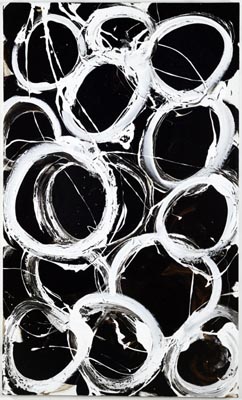Clinton Nain’s work deals with one of the most fundamental aspects of making art – a heightened appreciation and understanding of materials. People forget that making art is about the very stuff that actually makes it and an appreciation for materials gets relegated to the lower depths of Pre-Modernism next to sculpting stone and egg tempera techniques. It’s something you’re supposed to know but not supposed to talk about (except if you’re a painter and want to discuss grinding your own whites). Given that Nain’s work also carries with it a decidedly post modernist notion of subject in the form of a highly astringent strain of irony, the meeting of materials and concept feels like a complete surprise.

Clinton Nain, No Entry Home, detail 2005
Acrylic, bitumen on canvas, 152 x 92 cm.
Courtesy the artist and Sherman Galleries, Sydney
Nain’s work has mined the artist’s personal experiences as a gay Aboriginal man and the stories of his family for his subject matter. His use of bleach to paint directly onto unprimed canvas was a conceptual double whammy – not only did the works have a convincing and beautiful singularity, the subject was reinforced by the connotations of the materials. The works were paintings about being paintings as well as being about something else. It was an art value-add that one rarely encounters in the single channel world of ‘big idea’ post modernity.
The Dirty Deal Aint Clean finds the artist expanding his painting in new directions courtesy of the possibilities of bitumen, acrylic and enamel house paints, White King bleach bottles (in a nod to his previous use of symbolically overwrought found materials) and inks on canvas. Since the possibilities for a ghastly mélange are so high, it’s a tribute to Nain’s skills that the show’s 22 works hold together so well. Using a simplified and idiomatic symbolic language that so honed it resembles cartooning, Nain’s work declare their subject without hesitation.
We found ourselves lost in the sheer beauty of his minimalist use of materials. The loaded surfaces of Nain’s canvases in their big stretches of single colours are wracked with lines and cracks and reminded us of 60s and early 70s abstraction and the monstrously dense surfaces of canvases by painters like Elwynn Lynn and Keith Looby, not that Nain is referencing the muddy fields of pre-acrylic sludge but his unblushingly bold use of surface is a close relative.
